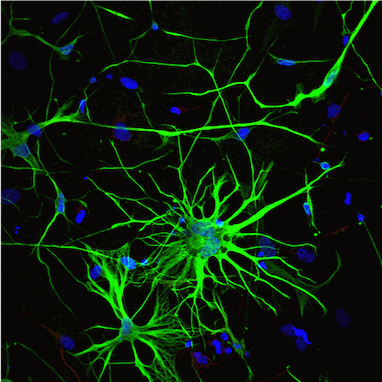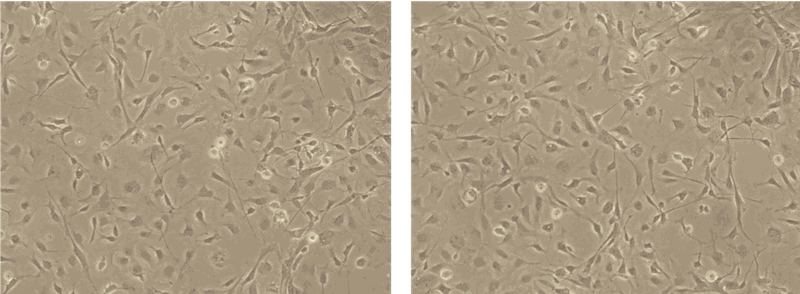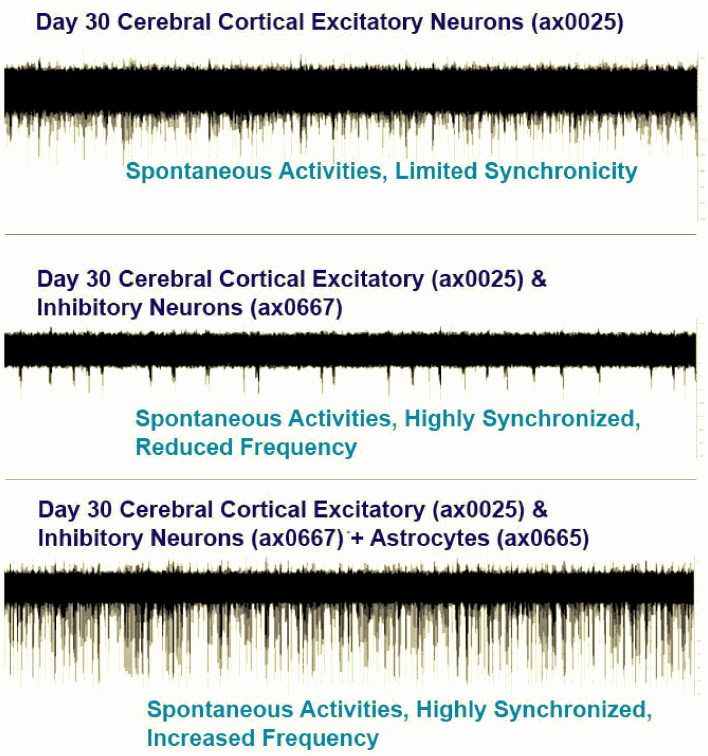Human iPSC-Derived Astrocytes

iPSC-derived Astrocytes
Axol’s Human iPSC-derived Astrocyte Kits include cryopreserved cells, optimised media and supplements. These kits offer researchers a complete culture system that is easy-to-use and promotes long-term cell viability for use in disease modelling and drug discovery applications.
Astrocyte dysfunction has been implicated in a number of neurological conditions such as Alzheimer’s and Parkinson’s diseases, autism, amyotrophic lateral sclerosis (ALS), Rett syndrome and schizophrenia. Axol’s Human iPSC-derived Astrocyte Kits offer a physiologically-relevant tool to study these cells as an isolated population or in co-culture with neurons for complex analysis of the central nervous system (CNS). Human iPSC-derived Astrocyte Progenitors are designed to generate mature astrocytes in under three weeks and iPSC-derived Mature Astrocytes express prototypical phenotype markers such as, glial fibrillary acidic protein (GFAP) and S100b. Our Human iPSC-Derived Astrocyte Progenitor and iPSC-Derived Mature Astrocyte Kits will help researchers gain further insight into the mechanisms that govern CNS development, disease onset and drug response.
iPSC-derived astrocytes
| Cat. No. | Product Name | Donor | Starting Material | Quantity | |
|---|---|---|---|---|---|
| ax0665 |
Human iPSC-derived Astrocyte |
Male, newborn |
Cord blood CD34+ cells |
1 million cells per vial |
Astrocyte culture media and reagents
| Cat. No. | Product Name | Quantity | |
|---|---|---|---|
| ax0086 | Astrocyte Maintenance Medium | 100 mL (Basal medium with supplements) | |
| ax0053 | SureBond-XF (Coating Substrate) |
|
1 mL (200X solution) |
Phase contrast images

Phase contrast images of Axol Human iPSC-derived Astrocyte at day 1 in culture. Human iPSC-derived Astrocytes are seeded using Astrocyte Maintenance Medium into a 6-well plate.
MEA characterization of cerebral cortical neuron-astrocyte co-culture

iPSC-derived cerebral cortical interneurones (ax0667) inhibit and modulate activities of the excitatory neurons - less individual spikes, more bursts; iPSC-derived astrocytes (ax0665) provide a supportive, physiologically relevant environment where the cortical neurons exhibit faster maturation as demonstrated by larger spike amplitudes, more frequent spikes and more burst activities.
Immunocytochemistry

Axol iPSC-derived astrocytes express astrocyte-specific markers GFAP and S100B. Low expression of nestin, a marker of progenitor cell phenotype and MAP2, a marker of microtubule growth and neuritogenesis, indicates successful glial differentiation of the iPSCs. Cells seeded on Matrigel at 16,000 cells/well of a 96-well plate. Data provided by Susanne Zach, Boehringer Ingelheim.

Axol iPSC-derived astrocytes express astrocyte associated markers excitatory amino acid transporter 1 (EAAT1), glutamine synthetase (GS) and ALDH1L1. EAAT1 is active in clearing excitatory glutamate from the extracellular space, preventing neurotoxicity where GS converts glutamate to glutamine. The expression of these markers highlights that Axol’s Human iPSC-derived Astrocytes are physiologically representative of human primary astrocytes. Cells seeded on Matrigel at 16,000 cells/well of a 96-well plate. Data provided by Susanne Zach, Boehringer Ingelheim.
Calcium activity
Axol’s Human iPSC-derived astrocytes were cultured for 7 weeks before measuring the baseline calcium activity.
Human iPSC-derived astrocytes were loaded with Fluo-4-AM (Thermofisher) calcium dye (1:10 dilution) and incubated for 1 hour at 37oC. The basal activity was recorded without stimulus at a rate of 1 fps. Video clip represents 60 seconds of activity compressed in 5 seconds for visualization. Data kindly provided by Abby Scurfield, Amit K. Chouhan and Prof Gareth Miles (University of St Andrews).